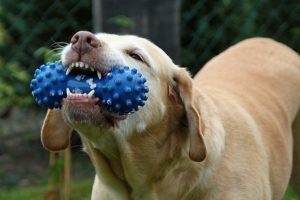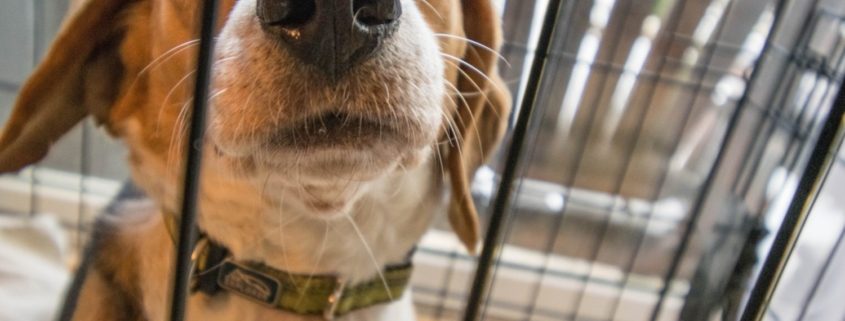Ask Crystal: Training an High Energy, Destructive Dog
Welcome to “Ask Crystal,” where you can ask your pet behavior questions! You can submit your question for Crystal at the bottom of the page!
Dear Crystal,
We recently adopted a new dog and she is being quite destructive. We tried crating her and she ripped the crate to shreds. The next day we left her in our bedroom, and she destroyed the entire room. I really don’t know what to do if we can’t crate her and we can’t leave her loose. Do you think she might have separation anxiety? Please help!
Sincerely,
At my wits end
Dear At,
This is defiantly a tough problem that seems a lot more commonplace than most people think it would be. I see it a lot in dogs that are very high energy, intelligent, and/or anxious dogs. Dogs certainly can have separation anxiety or isolation anxiety and become very destructive because of it. It would be difficult for me to determine if that is the cause, based on the information you have given me. The most likely cause is that she was not properly introduced to the crate and is a high energy dog that is not getting enough exercise.
I have noticed a lot of people really don’t follow any sort of training procedure to train the dog to actually enjoy being in a crate. Some dogs may seem to easily go into the crate the first couple of days because they are scared of the new surroundings, but they don’t enjoy it in normal circumstances. As they get more comfortable in your home, they start to become very uncomfortable with the confinement. Dogs don’t naturally enjoy being confined in a small crate, so we have to train them to like it. Depending on the dog’s history it may take a week or so to get her there or it could take longer. Once the dog really enjoys the crate, you will often find them sleeping in it when they don’t have to. I remember walking around the house looking for my dog, only to find him snoozing in the crate. In the meantime, you need to make alternative plans for the dog while you are working on training her. Could you possibly afford a couple weeks of dog daycare? Or maybe you have a neighbor that is home during the day that you could pay to have the dog hang out with them during the day. Another option could be one of those outdoor pens set up outside or in the garage if the weather allows. Remember hopefully this part will only be temporary while you work on the crate training and the reasons why the dog is destructive.
 As far as the crate training, you need to start at step one. I would start by playing training games to get the dog comfortable going in and out on their own and then shutting the door for short period of time. You toss a very high value treat right at the door opening. Start tossing the treats further and further back in so the dog has to go in and out of the crate. Go as slow as the dog needs to go. If they seem reluctant, we aren’t trying to force them. We don’t want to shut the door until the dog seems at ease being in the crate. At this point, I would sit and feed the dog through the crate and then let her out after a couple minutes. You can start to increase the amount of time with the door closed and then walk away for a minute and come back and let the dog out as long as she is quiet. I would also suggest that you feed all her meals in the crate. Place her kong just inside the door of the crate, at this point we aren’t going to shut her in. I just want her to go in willingly and get it. I will slowly work on each time placing it further back in the crate. As the dog seems comfortable going in and out, I will then shut the door while they eat. Check out Crate Games by Susan Garrett for a lot of fun games to play in the crate with your dog. If the dog likes toys more than food, we can play fetch or play with toys with the dog in the crate.
As far as the crate training, you need to start at step one. I would start by playing training games to get the dog comfortable going in and out on their own and then shutting the door for short period of time. You toss a very high value treat right at the door opening. Start tossing the treats further and further back in so the dog has to go in and out of the crate. Go as slow as the dog needs to go. If they seem reluctant, we aren’t trying to force them. We don’t want to shut the door until the dog seems at ease being in the crate. At this point, I would sit and feed the dog through the crate and then let her out after a couple minutes. You can start to increase the amount of time with the door closed and then walk away for a minute and come back and let the dog out as long as she is quiet. I would also suggest that you feed all her meals in the crate. Place her kong just inside the door of the crate, at this point we aren’t going to shut her in. I just want her to go in willingly and get it. I will slowly work on each time placing it further back in the crate. As the dog seems comfortable going in and out, I will then shut the door while they eat. Check out Crate Games by Susan Garrett for a lot of fun games to play in the crate with your dog. If the dog likes toys more than food, we can play fetch or play with toys with the dog in the crate.
One of the main reasons why dogs are destructive is boredom. We get these young, active animals in our homes and expect them to be content with a 15-minute daily walk. Maybe when they are older, that will probably suffice but young dogs need a lot more stimulation. If you have read my posts before then you know I am going to suggest that you only feed from enrichment toys. I think people severely underestimate the value of making your dog work for their food. My dogs love eating from toys, it is pretty much the only toys they want to play with. It took some time for me to teach my newest dog to use them but now he can solve the hardest puzzles. Dog daycare can be a great energy burn for dog friendly dogs or if you have friends who have friendly dog playmates set up play dates as frequently as possible. Training is going to help a lot with mental stimulation which helps alleviate boredom and burns energy. Try to fit training games into your day as often as possible. If you aren’t familiar with training games, take a group class. You will learn so much about how your dog learns and how to communicate with your dog on top of training games that will help her to use her mind and be a happier dog. You don’t have to walk your dog to exercise them. My dog’s favorite game is the flirt pole which is basically a cat teaser but dog size that I drag around the yard and he chases and catches. I like to incorporate impulse control training into it as well, so he is learning while we play. If your dog likes to tug that can be a great game to burn energy. Fetch can be a classic energy burn or teach your dog to catch a Frisbee. If you do take walks, the most enriching walks for dogs are going to be those where we really let them sniff and explore. I like to call these sniffy walks. I often let the dog decide where to go as long as it is safe and let them sniff whatever they want as long as they want. I use this time to catch up on my favorite podcasts so I don’t get bored.
 The other piece is of course offering a lot of interesting hard chew toys to give them the opportunity to chew on appropriate items. I suggest keeping toys on rotation, so your dog is less bored with the toys. Chew toys need to be hard to get the need to chew satisfied and to be safe.
The other piece is of course offering a lot of interesting hard chew toys to give them the opportunity to chew on appropriate items. I suggest keeping toys on rotation, so your dog is less bored with the toys. Chew toys need to be hard to get the need to chew satisfied and to be safe.
I would suggest that you try all the tips for a while and give her some time to settle in. It can take a couple or more months for a dog to really settle into a home routine. If your problems continue or you find that she is experiencing a lot of anxiety, I would suggest contacting a certified pet dog trainer. The Certification Council for Professional Dog Trainers has a certified trainer locator on their website.
Until next time,
Crystal







